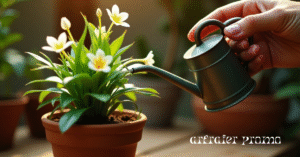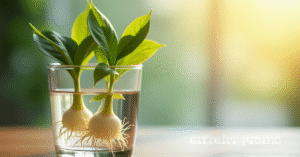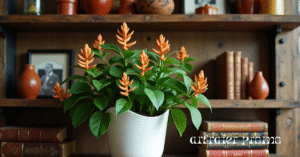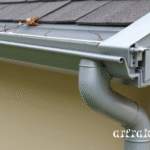Goldfish plants (Nematanthus gregarius) are stunning indoor plants known for their bright, orange-red blooms that resemble tiny goldfish leaping from green foliage. Native to Central and South America, these tropical beauties bring a splash of color and charm to any indoor space. With proper care, goldfish plants can thrive for years, offering cheerful flowers and vibrant greenery even in small apartments.
In this complete indoor guide, you’ll learn everything from lighting and watering needs to propagation methods, common problems, and where to buy healthy goldfish plants online.
What Is a Goldfish Plant?
The goldfish plant, scientifically known as Nematanthus gregarius, belongs to the Gesneriaceae family. It’s a trailing or cascading houseplant with thick, glossy green leaves and tubular flowers that resemble goldfish — hence the name.
This plant grows well indoors, especially in hanging baskets or elevated planters, where its vines can gracefully spill over the edges.
Types of Goldfish Plants
There are several varieties of goldfish plants, each with slightly different leaf shapes, bloom colors, and growth habits. Below are some of the most well-known and widely grown types:
| Goldfish Plant Type | Description | Unique Feature |
|---|---|---|
| Nematanthus gregarius | The most common variety, known for bright orange, fish-shaped blooms. | Classic trailing type, easy to grow. |
| Nematanthus ‘Tropicana’ | Features deep green foliage with larger, more vivid orange-red flowers. | Vigorous bloomer with bold color contrast. |
| Nematanthus ‘Black Gold’ | Has dark, almost black leaves with a glossy finish and fiery orange flowers. | High contrast between foliage and flowers. |
| Nematanthus ‘Golden West’ | Produces yellow-orange flowers with slightly lighter green leaves. | Unique golden-toned blooms. |
| Nematanthus ‘Lollipop’ | Compact, bushy form with red-orange tubular flowers. | Great for small pots or tight spaces. |
| Nematanthus wettsteinii | Smaller leaves and trailing habit with consistent blooming. | Excellent for hanging baskets. |
Benefits of Growing Goldfish Plant Indoors
-
Vibrant Blooms: Produces eye-catching orange and red flowers throughout the growing season.
-
Compact & Manageable: Perfect for hanging baskets or shelf displays.
-
Air Purification: Helps clean indoor air, like many houseplants.
-
Low-Maintenance: Great for beginners who want something unique yet easy to manage.
Ideal Growing Conditions
To keep your goldfish plant happy and blooming indoors, provide the following conditions:
-
Light: Bright, indirect sunlight. Avoid direct midday sun, which can scorch the leaves.
-
Temperature: Thrives between 65°F to 75°F (18°C to 24°C). Protect from cold drafts.
-
Humidity: Prefers humidity levels above 50%. Mist regularly or use a humidifier in dry environments.
-
Soil: Well-draining potting mix. A mix of peat moss and perlite or orchid bark works well.
How to Water Goldfish Plant
-
Allow the top 1 inch of soil to dry before watering.
-
Use room-temperature water and avoid letting the plant sit in standing water.
-
Reduce watering frequency in winter when growth slows down.
-
Overwatering is a common problem—always check the soil first.

Fertilizing Tips
-
Use a balanced, water-soluble fertilizer (like 10-10-10) every 2–4 weeks during the spring and summer.
-
Stop fertilizing in the fall and winter.
-
Over-fertilizing can lead to salt buildup and leaf damage.
Pruning and Maintenance
-
Regularly trim back long vines to encourage bushier growth.
-
Pinch off the tips to promote branching and fuller foliage.
-
Remove any yellow, dead, or damaged leaves promptly.
-
Clean leaves occasionally to prevent dust buildup and improve light absorption.
How to Propagate Goldfish Plant
Goldfish plants are easy to propagate through stem cuttings. Here’s how:

-
Choose a healthy stem with at least two leaf nodes.
-
Cut a 4–6 inch section just below a node.
-
Remove the lower leaves.
-
Place the cutting in water or moist potting mix.
-
Keep it in a warm, bright area (not direct sunlight).
-
Roots typically appear in 2–4 weeks.
Once roots are established, transplant into a small pot with well-draining soil.
Common Problems and Solutions
| Problem | Cause | Solution |
|---|---|---|
| Yellowing Leaves | Overwatering or poor drainage | Allow soil to dry, improve drainage |
| No Blooms | Lack of light or fertilizer | Increase light, apply regular feeding |
| Leaf Drop | Temperature fluctuations | Keep in stable environment |
| Moldy Soil | Overwatering or poor airflow | Improve ventilation, reduce watering |
| Brown Leaf Tips | Low humidity | Mist regularly or use a humidifier |
Where to Buy Goldfish Plant
You can find goldfish plants at many popular online plant stores and local nurseries. Here are a few reliable options:
-
Amazon – Offers potted plants and starter kits.
-
Etsy – Great for buying rooted cuttings or unique varieties from plant sellers.
-
Home Depot / Lowe’s – Check their garden section both in-store and online.
-
Specialty Plant Shops – Local nurseries often carry healthier, locally grown plants.
You can also learn more about tropical houseplants and care routines with expert resources from trusted garden sites.
Indoor Styling Ideas
-
Hanging Baskets: Let the trailing vines fall beautifully over the sides.
-
Macrame Holders: Add a boho touch to your indoor décor.
-
Wall Shelves: Place in a bright spot near a window for cascading beauty.
-
Colorful Pots: Use orange or gold pots to enhance the bloom tones.

Conclusion
The goldfish plant is a delightful indoor addition that offers charm, color, and minimal fuss. With the right care—bright, indirect light, moderate watering, and occasional feeding—you can enjoy its vibrant blooms and healthy foliage year-round.
Whether you’re a beginner or a seasoned plant enthusiast, the goldfish plant is a rewarding choice that instantly livens up any indoor space.
Frequently Asked Questions (FAQs)
What is the best spot to place a goldfish plant indoors?
Near an east- or north-facing window with bright, indirect sunlight.
How often should I water a goldfish plant?
Water once the top inch of soil dries out—typically once a week, less in winter.
Can I grow a goldfish plant from a cutting?
Yes, it propagates easily from stem cuttings placed in water or moist soil.
Why is my goldfish plant not blooming?
Lack of light, infrequent feeding, or cold temperatures can delay blooming.
Is the goldfish plant toxic to pets?
It’s generally considered non-toxic, but always check with your vet.
Do goldfish plants need sunlight?
Yes, they need bright, indirect sunlight. Direct sun may burn the leaves.
What is the scientific name for the goldfish plant?
The goldfish plant is scientifically known as Nematanthus gregarius.





